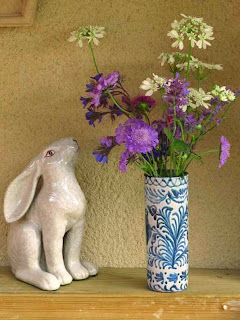"It isn't that I don't like sweet disorder, but
it has to be judiciously arranged."
- Vita Sackville-West
- Vita Sackville-West
 |
| Papaver rhoeas - Common Poppy |
Out in the countryside shades of white still seem to prevail, with hawthorn blossom giving way to creamy clusters of dogwood (Cornus sanguinea) dotting the hillsides and interspersed on field margins with the large, saucer-shaped blooms of elder (Sambucus nigra). It might be tempting to make a batch of elderflower cordial if it were not for the huge amount of sugar involved!
 |
| Anacamptis pyramidalis |
Orchids, too, are ten-a-penny in meadows and waysides thanks to all the earlier rain.
So-called pyramid orchids, which are not true orchids at all, are particularly widespread and luscious, making it hard to resist the impulse to pick a few and bring them home to admire in a vase...
 |
| Ophrys scolopax |
This cleverly designed orchid is able to self-pollinate if there are not enough bees around to do the job - its pollen sacs are the yellow part protruding above the 'lip' of the flower.
 |
| Admiring a floral offering... aquilegia, scabious, orlaya and Knautia macedonia (dark pink) |
Ideas for Edging
Neither of us recalls actually buying the two clumps of scabious that have been in flower continuously for over a month, so I think it may have been a case of pulling up a couple of 'bits' during one of our walks last year!
As there's nothing remotely endangered about scabious, I can't feel guilty for purloining a plant or two and I'd definitely recommend it for use as border edging, especially if regularly dead-headed.
 |
| The new raised bed with Cerastium tomentosum var. columnae |
Another attractive edging for raised beds is the tumbling silver-leaved Cerastium 'Silver Carpet', also known as Snow-in-Summer, which can spread its silvery mat over dry areas of gravel or on rockeries, acting as a useful weed-suppressant. Once established, it's simple to transplant rooted pieces around the garden.
Sowing Seeds
 |
| Dianthus barbatus 'Homeland' and Penstemon digitalis 'Husker Red' |
It has encouraged me to become more adventurous over the years and look for interesting foliage as well as flowers. For instance, the 'Homeland' variety of sweet william in this picture is nicely offset by spires of a purple-leaved penstemon which is just coming into bloom.
Most gardens need some dark foliage to break up the sea of greenery.
And it's equally important, of course, to have plants of vertical interest to draw the eye upwards.
These foxgloves just happened to seed themselves in dappled shade under our tall ash tree and, together with the creamy blossom of pyracantha, they echo some of the wild plants growing in adjacent meadows.
Even the dots of red provided by flowers of Geum chiloense could be mistaken for field poppies!
Chelsea Fashions
 |
| Anchusa azurea 'Dropmore' |
Chiltern Seeds always take note of what is popular at the Chelsea Flower Show and last year's TV coverage featured several shots of anchusa. Like celebrity chefs endorsing use of a particular culinary ingredient, suddenly it becomes the must-have plant for gardeners!
I duly grew some from seed last autumn and each of those plants has rewarded us with several branches of bright flowers.
 |
| Lysimachia atropurpurea 'Beaujolais' |
The glaucous, spiky foliage sets it apart from other border perennials and its wine-coloured flowers take a few weeks to develop, adding to a sense of anticipation in those of us unfamiliar with its unusual style.
As it's my first season growing some of these perennials, I need to look carefully at where best to site them in the border, taking into account companion plants. No doubt there'll be lots of moving around come autumn!
Growing Grasses
 |
| Stipa gigantea |
Its decorative pannicles catch the light and dance over the ferny foliage of nigella and larkspur which are all coming into bloom now.
 |
| Stipa gigantea and friends |
Although I sense this Stipa will probably become too big for the bed after three years, its open framework means that at present it doesn't crowd neighbouring perennials unlike other grasses which form dense clumps.
For instance, we found that the plumy Chinese Fountain Grass, Pennisetum alopecuroides, spread too quickly; lovely though it was, we took the decision to dig it up from the back garden where it provided just too much of a screen. (Having grown this from an inexpensive packet of seeds, I didn't have to feel too guilty about wasting money..!)
 |
| An excellent year for roses - even wild ones |

No comments:
Post a Comment